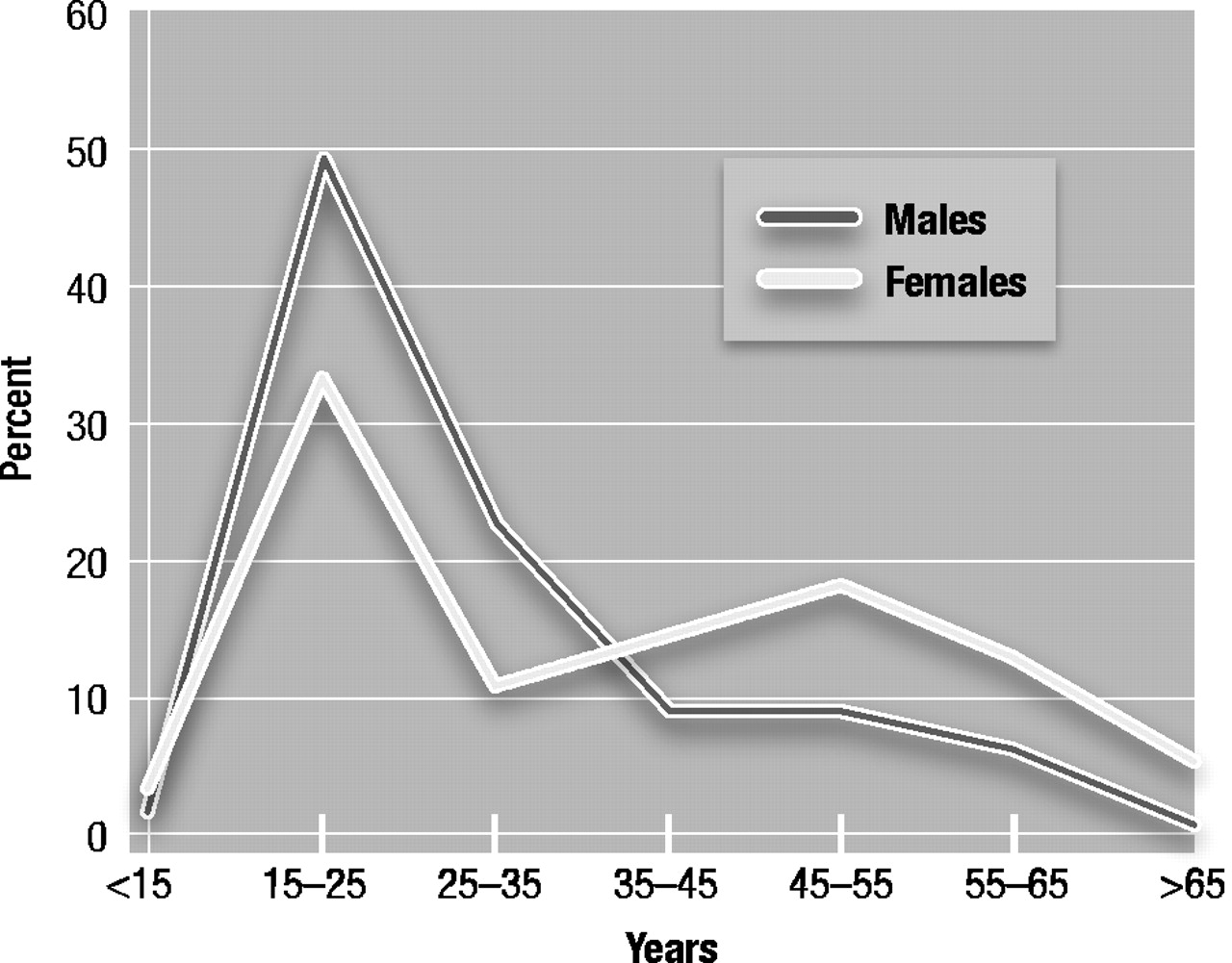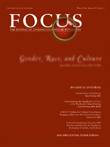There have been few treatment studies investigating the effect of estrogen on psychopathology in women with schizophrenia.
Kulkarni and colleagues (1995) reported that the administration of 0.02 mg estradiol to premenopausal women with schizophrenia or schizoaffective disorder for 1 month in conjunction with standardized neuroleptic treatment decreased the total score on the SAPS to a greater extent than in a comparison group of women who received neuroleptics only. At the end of 2 months’ treatment with estradiol, however, the scores on the SAPS increased. Kulkarni and colleagues concluded that estradiol might enhance the effects of neuroleptics to reduce positive symptoms initially but that this effect might be reversed with longer administration of estradiol. There has also been a case report of the effect of estrogen treatment on psychotic symptoms in a 48-year-old woman with schizoaffective disorder with premenstrual exacerbation of symptoms. Treatment with 3.0 mg of estradiol (percutaneous) for 5 months increased her serum level of estradiol from 50 pmol/L to 140 pmol/L and increased her subjective sense of well-being (
Korhonen et al. 1995). The patient self-discontinued her “psychotropic” medication (the type of medication was unspecified) 1 month after beginning estrogen therapy and had no relapse over the next year.
Recently, we designed a treatment study to investigate the effects of estrogen supplementation in postmenopausal women with schizophrenia. Outpatient women stable on neuroleptics receive psychiatric and neurological examinations. After a comprehensive physical evaluation, including a mammogram, pelvic examination, Pap smear, and vaginal ultrasound, subjects are considered for possible eligibility for the study. We administer transdermal patches of 0.05 to 0.10 mg of Estraderm, changing twice a week for 4 months. Standardized measures of psychopathology and motor function are given monthly, and blood is drawn for measuring levels of estradiol and neuroleptics. Cognitive functioning (i.e., attention, learning, and memory) is evaluated at baseline, 2 months, and 4 months. Below we present a selected case report of estradiol augmentation of neuroleptics, in a postmenopausal woman with schizophrenia.
Case report
Ms. A was a 49-year-old, divorced, Caucasian woman who completed high school and earned an Associates Degree in Human Growth and Development at a community college. She then worked as a teacher in a nursery school and later in a school for developmentally delayed children. In 1971, she enlisted in the Navy, working as a secretary and dental technician. She married and was honorably discharged in 1972 due to pregnancy. She divorced in 1979 and moved in with her parents, giving her 4 children up for adoption. Although she attended adult education classes to become a medical assistant, worked as a security guard, and obtained a cosmetology license, she had difficulty maintaining employment and went into debt. Her living arrangements alternated between living with partners when she was involved in a relationship and living with her parents when the relationship ended.
Her psychiatric history consisted of evaluation at the age of 12 for an unspecified learning disability. The age at first psychiatric contact for possible schizophrenia was 26 years when Ms. A was seen for several weeks for “apprehension” while in the service. Although she continued to experience disorganization in her thoughts and behavior, she was not diagnosed as having schizophrenia nor did she receive regular psychiatric care until 1995.
In April, 1995, Ms. A’s mother died. Ms. A was referred by a gastroenterologist three months later to the Psychiatric Emergency Clinic, stating that she could not earn a living because of depression, confusion, and poor memory and concentration. After several outpatient appointments, she was hospitalized for the first time in August 1995 with tangential speech, disorganized behavior, mild paranoia, and inappropriate affect. Ms. A described her condition as feeling like “there is something wrong with my brain.” She denied auditory and visual hallucinations at admission but manifested auditory hallucinations during her hospital course; these resolved before discharge. A structured clinical interview (SCID;
Spitzer et al. 1988) revealed that in the past, Ms. A had experienced hearing voices commenting on her behavior, as well as visual, tactile, and olfactory hallucinations. On observation, she demonstrated loosening of associations, incoherence, inappropriate affect, and posturing. Although she described some depressed mood, she denied anhedonia and other symptoms of depression. DSM-IV (
American Psychiatric Association 1994) symptoms of mania were not observed. Ms. A denied a history of alcohol or other drug abuse, seizure disorder, closed head injury, or other neurological disorder. Family psychiatric history was positive for schizophrenia in her aunt and mother. Her DSM-IV diagnosis was schizophrenia, disorganized type (295.10).
Medical history was significant for spastic colitis, asthma, and vitamin B12 deficiency. She had a bladder suspension in 1977 and a hysterectomy in 1979 for menorrhagia related to leiomyoma. Physical examination was unremarkable. CT head scan was within normal limits.
On neuropsychological performance, Ms. A scored a 29/30 on the Mini-Mental State Examination (
Folstein et al. 1975). Her WAIS-R Full Scale Intelligence Quotient (I.Q.) (
Wechsler 1981) was 100, her verbal I.Q. was 106, and her performance I.Q. was 93, thus placing her intellectual functioning in the average range. Her performance on the WAIS-R subtests was in the low average to average range with the exception of a test of attention to visual detail (Picture Completion) which fell in the mildly to moderately impaired range. Ms. A demonstrated a mild impairment of visuospatial learning (Story Learning) and concept formation (Booklet Category Test). Achievement tests of reading comprehension and spelling (PLAT) were in the mildly to severely impaired range, respectively, confirming her subjective complaints of learning difficulties. Reading recognition, however, was in the high average range, greater than a 12 grade level.
Ms. A had never been prescribed neuroleptic medication prior to this hospitalization. At admission, Ms. A’s total score on the positive syndrome scale of the Positive and Negative Syndrome Scale (PANSS;
Kay et al. 1987) was 22. Her total score on the negative syndrome scale was 21 and she scored 48 on the global psychopathology scale. During her hospital course, Ms. A was enrolled in a randomized, double-blind drug study of an atypical antipsychotic. She discontinued just prior to entering the open-label phase. After terminating the drug study, Ms. A was prescribed perphenazine 8 mg and discharged 3 days later. After about 2 weeks, the dose of perphenazine was increased to 12 mg and remained at that dose for several months. Prior to enrollment into the estrogen replacement therapy (ERT) protocol, Ms. A’s positive, negative, and global psychopathology scores on the PANSS were 15, 7, and 30, respectively. Following 4 months of administration of 0.05 mg Estraderm, her PANSS positive syndrome scale dropped to 9, while her negative syndrome score was 9, and global score 31. After 2 weeks off estradiol, Ms. A requested an increase in her dose of perphenazine “to improve my thinking and to calm me down.” Six weeks after discontinuing the ERT and increasing her dose of perphenazine to 16 mg, Ms. A’s score on the PANSS positive syndrome scale was 22, on the negative syndrome scale was 8, and on the global psychopathology scale was 32. At her request, and as agreed by her physician, she was started on 0.625 mg Premarin and was being monitored for changes in psychopathology.
This case report illustrates the possible beneficial effects of estrogen augmentation of neuroleptic treatment in postmenopausal women with schizophrenia. In this case, a middle-aged woman with schizophrenia had a reduction in positive symptoms (but not in negative symptoms or global psychopathology) while on ERT and a return of near baseline levels of positive symptoms when ERT was discontinued. While this single-case open study of the effects of ERT on psychopathology is intriguing, larger, double-blind treatment studies are needed.
In conclusion, the indirect evidence from clinical studies of gender differences in schizophrenia and from studies examining the relationship between levels of estrogens and psychopathology suggests a potential role for estrogen in delaying the onset or attenuating the severity of psychotic symptoms associated with schizophrenia. Direct evidence from biochemical and behavioral studies in animals indicates that estrogen interacts with dopamine, suggesting one possible mechanism for the protective effect of estrogen in schizophrenia. This hypothesis is partially supported from data from one published small open-label treatment study and the case study presented here of the estrogen augmentation of neuroleptic medication in postmenopausal women with schizophrenia. Adjunctive treatment of estrogen has considerable potential clinical significance, such as allowing a decrease in the dose of neuroleptic medication while maintaining efficacy and reducing the associated side effects. More studies, especially double-blind, randomized clinical trials of the effects of estrogen replacement therapy in conjunction with neuroleptic treatment on the psychopathology in schizophrenia are required before definitive conclusions about the benefits of estrogen supplementation can be drawn.


